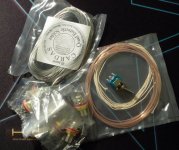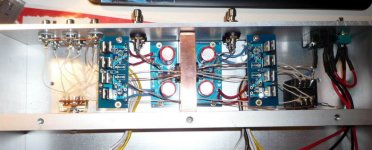cyxg said:Could you tell me how to improve it.
Some of the upgrades have been discussed here: http://www.diyaudio.com/forums/showthread.php?postid=1231532#post1231532
I want to add an input selector such as the one cyxg has built into his GC amp. I've found a few that look similar and don't clearly know what the specs mean and the specs required are.
I'd like 3 inputs, what kind of Rotary Switch should I go for?
I'd like 3 inputs, what kind of Rotary Switch should I go for?
mattcalf said:I want to add an input selector such as the one cyxg has built into his GC amp. I've found a few that look similar and don't clearly know what the specs mean and the specs required are.
I'd like 3 inputs, what kind of Rotary Switch should I go for?
Also for hookup wire, would this be suitable?
Hi,Matt
I use Rotary Wafer 3 Pole 4 Position, but i just use 2 pole(right/left)and 3 position.
About wire, the silver wire is better. i don't know how can i find it in Australir.
Attachments
cyxg said:
About wire, the silver wire is better. i don't know how can i find it in Australir.
Hi
I dont know about Australia but in Hong kong there is a good source
check this
I have tried them and they are fast and reliable.
Cheers
Nick
cyxg said:
Hi,Matt
I use Rotary Wafer 3 Pole 4 Position, but i just use 2 pole(right/left)and 3 position.
If it's not too much trouble could you email/pm/post a few photos highlighting your hookup to the Rotary Switch?
Thanks,
Matt.
tiglitosa said:
Hi
I dont know about Australia but in Hong kong there is a good source
check this
I have tried them and they are fast and reliable.
Cheers
Nick
Thanks, but I've found some decent enameled copper that I think I'll use.
Check this link for source selectors using rotary switches: http://www.diyaudio.com/forums/showthread.php?postid=1566942#post1566942
It's not possible to implement itt without resistors. Just use the size and color you like the most, adjust resistor accordingly to desired brightness: http://www.diyaudio.com/forums/showthread.php?postid=1517911#post1517911
mattcalf said:
If it's not too much trouble could you email/pm/post a few photos highlighting your hookup to the Rotary Switch?
Hi, Matt, Please see PIC
Attachments
mattcalf said:Another question:
With the pot, I've bought an ALPS 50k. What's will be the difference between using a 10k, 25k, and 50k?
Cheers,
Matt.
50K is better.
mattcalf said:Thanks, was hoping for a closer shot of actual wiring but this should help.
Another question:
With the pot, I've bought an ALPS 50k. What's will be the difference between using a 10k, 25k, and 50k?
Cheers,
Matt.
50k = more attenuation, more silent in full ccw rotation i think since pots are logarithmic.
Nick
I wouldn't think so, too much copper is not a good idea either. I like to combine: copper for heat spreadign (and weight), aluminum for dissipation, that's how it's done in Patek amp: http://audiosector.com/chassis_patek2_amp.shtml
Thanks PeterPeter Daniel said:It's not possible to implement itt without resistors. Just use the size and color you like the most, adjust resistor accordingly to desired brightness: http://www.diyaudio.com/forums/showthread.php?postid=1517911#post1517911
I have read that post but I still fail to understand how you are getting to the proper resistor value. For example if I am working with dual 24V rails and am trying to use a standard 3V LED. What resistor would cause the LED to operate at 3V? Is there a simple calculation for this?
Peter Daniel said:I wouldn't think so, too much copper is not a good idea either. I like to combine: copper for heat spreadign (and weight), aluminum for dissipation, that's how it's done in Patek amp: http://audiosector.com/chassis_patek2_amp.shtml
Peter,
thanx for your responses.!
Yes i have seen the patek and its really very very neat !
But in my case the chip is mounted on a 12,8x12,8 1mm copper plate and i think i will add underneath a 12,8x12,8 4mm solid aluminum.
Will this be enough for heatsink?
And is there an online place to buy solid alimunum 12,8cm x12,8cm of lets say 1,2 cm thickness? I see you got some very good aluminum blocks.
Hi,Mike-Toronto said:I still fail to understand how you are getting to the proper resistor value. For example if I am working with dual 24V rails and am trying to use a standard 3V LED. What resistor would cause the LED to operate at 3V? Is there a simple calculation for this?
3V is not a standard LED, it may be a blue one.
First subtract the LED voltage from your supply voltage. Either 24V-3V or 48V-3V.
Look up the datasheet for the LED and decide roughly what current you would like to pass through the LED. More current = brighter, less current = dimmer, too much current = overheating or
 .
.Take the remaining voltage and your desired current and apply ohms law. I = V / R , rearranged as R = V / I
Let's use the 48V supply and 4mA as an example.
V = 48 - 3 = 45
I = 4 /1000 = 0.004
R = 45 / 0.004 = 11250ohms.
Use 11k
the actual current is given by I = V / R = 45 / 11k = 4.1mA.
Try this and see how bright it is. Then decide if you want/need more or less current.
tiglitosa said:
But in my case the chip is mounted on a 12,8x12,8 1mm copper plate and i think i will add underneath a 12,8x12,8 4mm solid aluminum.
Will this be enough for heatsink?
And is there an online place to buy solid alimunum 12,8cm x12,8cm of lets say 1,2 cm thickness? I see you got some very good aluminum blocks.

It might be a good idea to add aluminum plate underneath copper sheet (1mm is too thin to call it a plate) to reinforce it.
I can't say if it's going to be enough for heat dissipation as that will depend on type of music, volume level and type of speakers. In some cases it could be enough, but not when you really push the amp.
I would certainly consider some additional aluminum elements to increase the dissipating surface, but then agaun you can always do it later.
- Home
- More Vendors...
- Audio Sector
- Commercial Gainclone kit- building instructions



